The Cambridge History of China. Vol. 12: Republican China, 1912-1949, Part 1
Подождите немного. Документ загружается.

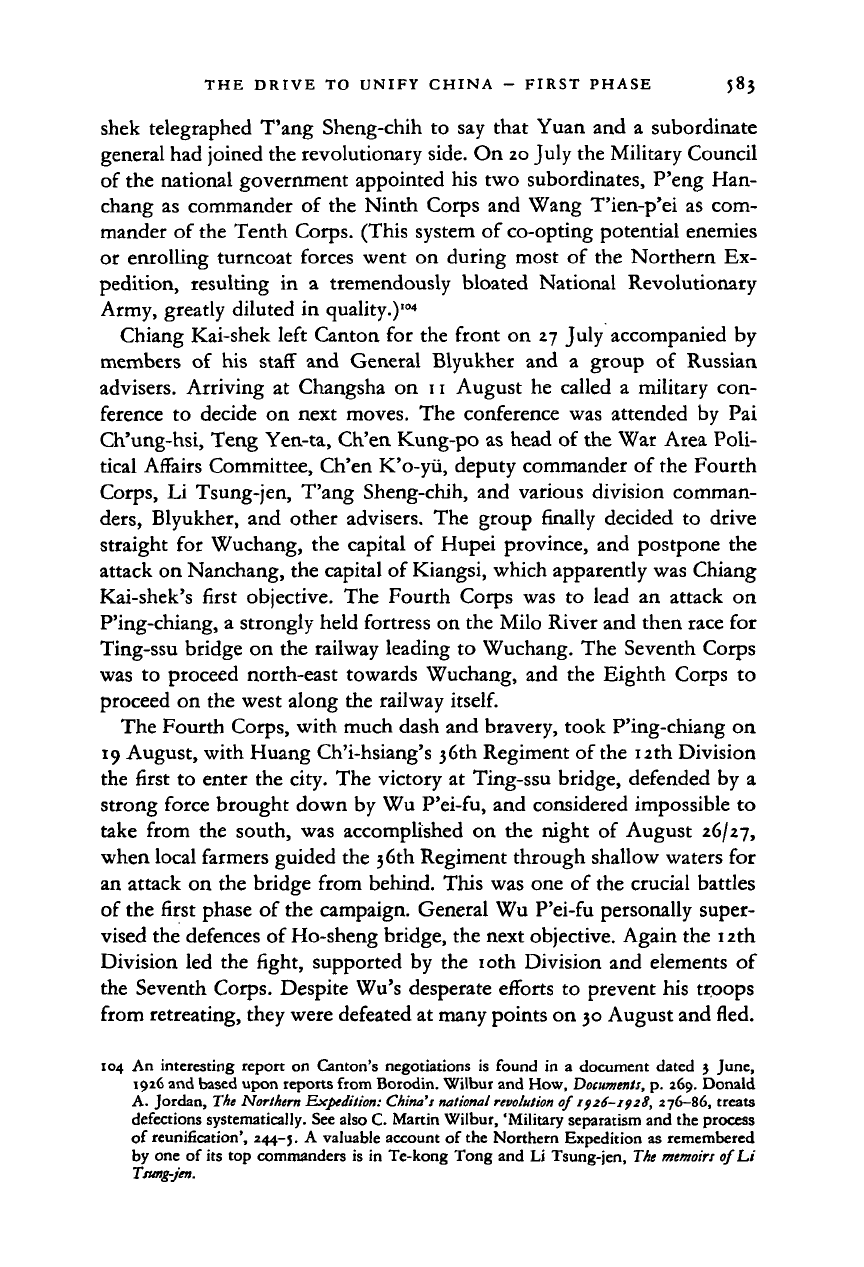
THE DRIVE TO UNIFY CHINA - FIRST PHASE 583
shek telegraphed T'ang Sheng-chih to say that Yuan and a subordinate
general had joined the revolutionary side. On 20 July the Military Council
of the national government appointed his two subordinates, P'eng Han-
chang as commander of the Ninth Corps and Wang T'ien-p'ei as com-
mander of the Tenth Corps. (This system of co-opting potential enemies
or enrolling turncoat forces went on during most of the Northern Ex-
pedition, resulting in a tremendously bloated National Revolutionary
Army, greatly diluted in quality.)'
04
Chiang Kai-shek left Canton for the front on 27 July accompanied by
members of his staff and General Blyukher and a group of Russian
advisers. Arriving at Changsha on 11 August he called a military con-
ference to decide on next moves. The conference was attended by Pai
Ch'ung-hsi, Teng Yen-ta, Ch'en Kung-po as head of the War Area Poli-
tical Affairs Committee, Ch'en K'o-yii, deputy commander of the Fourth
Corps, Li Tsung-jen, T'ang Sheng-chih, and various division comman-
ders,
Blyukher, and other advisers. The group finally decided to drive
straight for Wuchang, the capital of Hupei province, and postpone the
attack on Nanchang, the capital of Kiangsi, which apparently was Chiang
Kai-shek's first objective. The Fourth Corps was to lead an attack on
P'ing-chiang, a strongly held fortress on the Milo River and then race for
Ting-ssu bridge on the railway leading to Wuchang. The Seventh Corps
was to proceed north-east towards Wuchang, and the Eighth Corps to
proceed on the west along the railway
itself.
The Fourth Corps, with much dash and bravery, took P'ing-chiang on
19 August, with Huang Ch'i-hsiang's 36th Regiment of the 12th Division
the first to enter the city. The victory at Ting-ssu bridge, defended by a
strong force brought down by Wu P'ei-fu, and considered impossible to
take from the south, was accomplished on the night of August 26/27,
when local farmers guided the 36th Regiment through shallow waters for
an attack on the bridge from behind. This was one of the crucial battles
of the first phase of the campaign. General Wu P'ei-fu personally super-
vised the defences of Ho-sheng bridge, the next objective. Again the 12th
Division led the fight, supported by the 10th Division and elements of
the Seventh Corps. Despite Wu's desperate efforts to prevent his troops
from retreating, they were defeated at many points on 30 August and fled.
104 An interesting report on Canton's negotiations is found in a document dated 3 June,
1926 and based upon reports from Borodin. Wilbur and How,
Documents,
p. 269. Donald
A. Jordan, The Northern Expedition:
China's national revolution
of 1926-1928, 276-86, treats
defections systematically. See also C. Martin Wilbur, 'Military separatism and the process
of reunification', 244-5. A valuable account of the Northern Expedition as remembered
by one of its top commanders is in Te-kong Tong and Li Tsung-jen, The
memoirs
of Li
Tsung-jen.
Cambridge Histories Online © Cambridge University Press, 2008
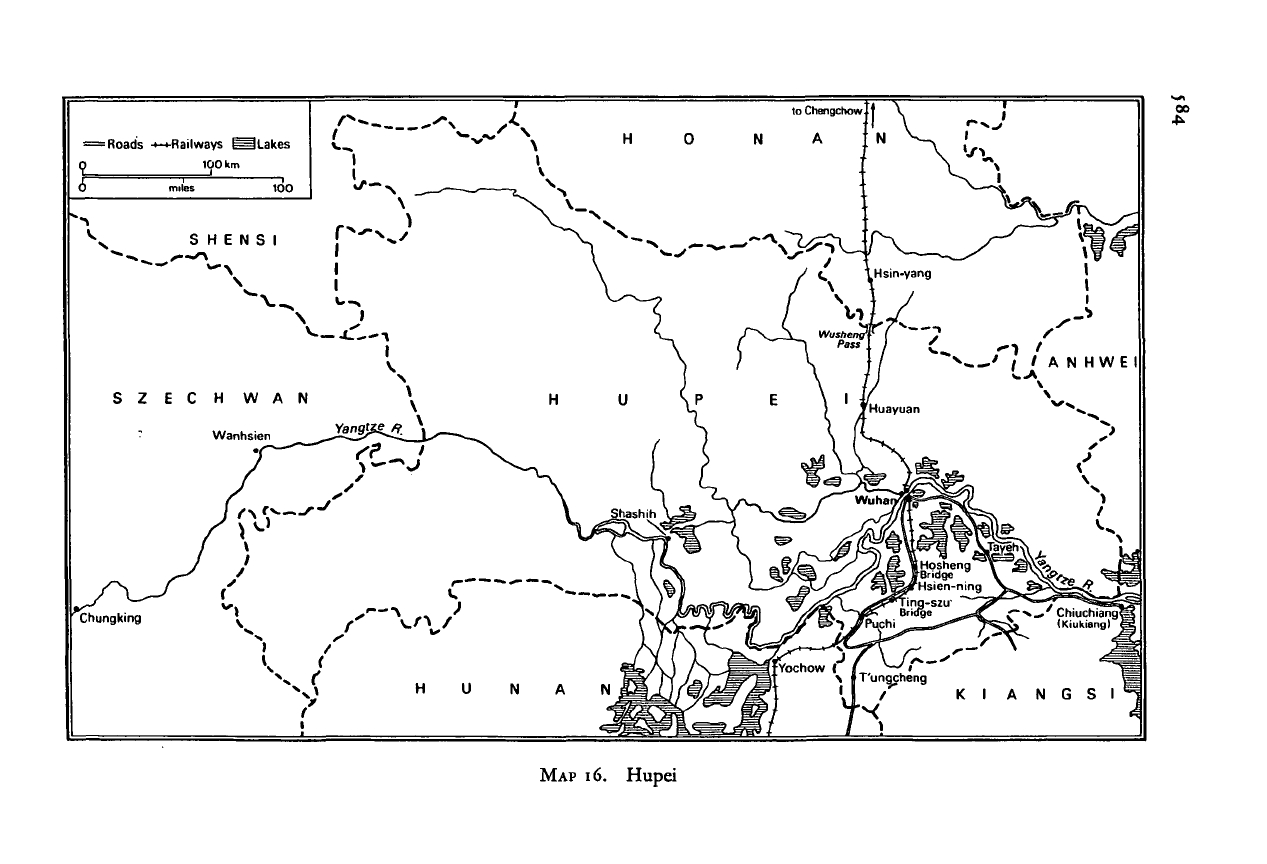
= Roads -*-*Railways HU Lakes
o 100 km
0miles 100
•-A
^J
S
H E N S I
"^/
I
SZECH
WAN
:
Wanhsien
MAP
I
6.
Hupei
Cambridge Histories Online © Cambridge University Press, 2008
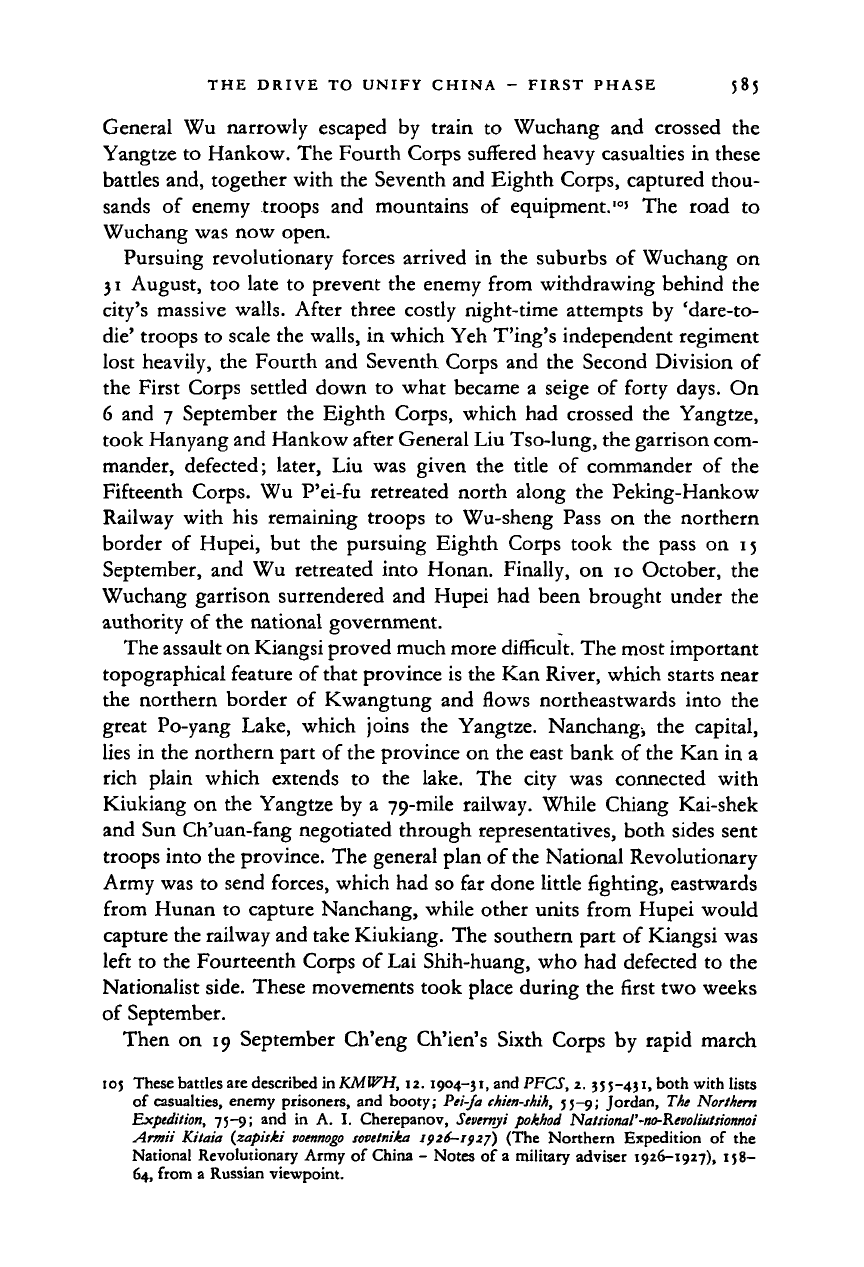
THE DRIVE TO UNIFY CHINA - FIRST PHASE 585
General Wu narrowly escaped by train to Wuchang and crossed the
Yangtze to Hankow. The Fourth Corps suffered heavy casualties in these
battles and, together with the Seventh and Eighth Corps, captured thou-
sands of enemy troops and mountains of equipment.
10
' The road to
Wuchang was now open.
Pursuing revolutionary forces arrived in the suburbs of Wuchang on
31 August, too late to prevent the enemy from withdrawing behind the
city's massive walls. After three costly night-time attempts by 'dare-to-
die'
troops to scale the walls, in which Yeh T'ing's independent regiment
lost heavily, the Fourth and Seventh Corps and the Second Division of
the First Corps settled down to what became a seige of forty days. On
6 and 7 September the Eighth Corps, which had crossed the Yangtze,
took Hanyang and Hankow after General Liu Tso-lung, the garrison com-
mander, defected; later, Liu was given the title of commander of the
Fifteenth Corps. Wu P'ei-fu retreated north along the Peking-Hankow
Railway with his remaining troops to Wu-sheng Pass on the northern
border of Hupei, but the pursuing Eighth Corps took the pass on 15
September, and Wu retreated into Honan. Finally, on 10 October, the
Wuchang garrison surrendered and Hupei had been brought under the
authority of the national government.
The assault on Kiangsi proved much more difficult. The most important
topographical feature of that province is the Kan River, which starts near
the northern border of Kwangtung and flows northeastwards into the
great Po-yang Lake, which joins the Yangtze. Nanchangj the capital,
lies in the northern part of the province on the east bank of the Kan in a
rich plain which extends to the lake. The city was connected with
Kiukiang on the Yangtze by a 79-mile railway. While Chiang Kai-shek
and Sun Ch'uan-fang negotiated through representatives, both sides sent
troops into the province. The general plan of the National Revolutionary
Army was to send forces, which had so far done little fighting, eastwards
from Hunan to capture Nanchang, while other units from Hupei would
capture the railway and take Kiukiang. The southern part of Kiangsi was
left to the Fourteenth Corps of Lai Shih-huang, who had defected to the
Nationalist side. These movements took place during the first two weeks
of September.
Then on 19 September Ch'eng Ch'ien's Sixth Corps by rapid march
105 These battles are described in
KMWH,
12. 1904-51, and PFCS, 2. 355-431, both with lists
of casualties, enemy prisoners, and booty; Pei-fa
chien-shih,
55-9; Jordan, The Northern
Expedition, 75-9; and in A. I. Cherepanov,
Severnyi
pokhod
Natsional'-no-Kevoliultiotmoi
Armii Kitaia (zapiski
voennogo
sovetnika 1926-1917) (The Northern Expedition of the
National Revolutionary Army of China - Notes of a military adviser 1926-1927), 158—
64,
from a Russian viewpoint.
Cambridge Histories Online © Cambridge University Press, 2008
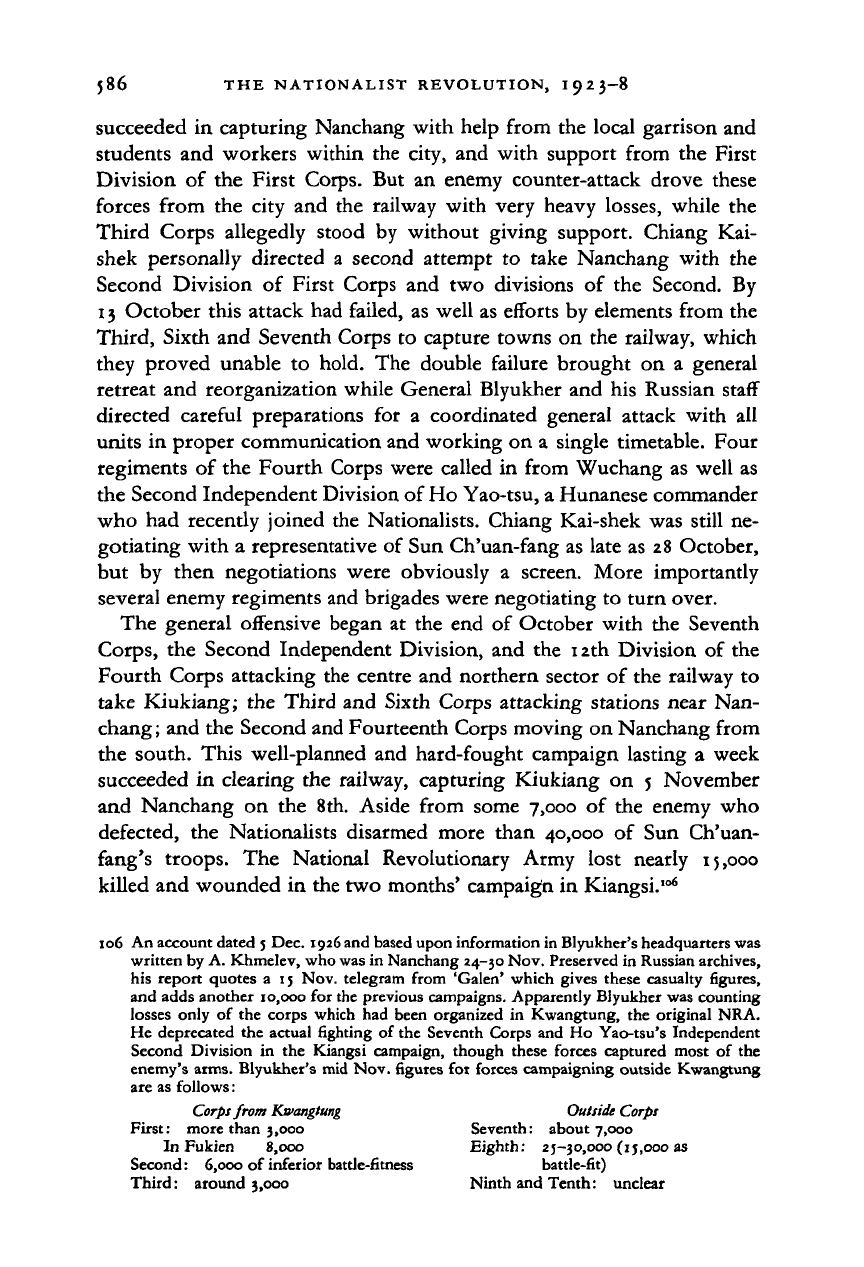
586 THE NATIONALIST REVOLUTION, I 9 2 3-8
succeeded in capturing Nanchang with help from the local garrison and
students and workers within the city, and with support from the First
Division of the First Corps. But an enemy counter-attack drove these
forces from the city and the railway with very heavy losses, while the
Third Corps allegedly stood by without giving support. Chiang Kai-
shek personally directed a second attempt to take Nanchang with the
Second Division of First Corps and two divisions of the Second. By
13 October this attack had failed, as well as efforts by elements from the
Third, Sixth and Seventh Corps to capture towns on the railway, which
they proved unable to hold. The double failure brought on a general
retreat and reorganization while General Blyukher and his Russian staff
directed careful preparations for a coordinated general attack with all
units in proper communication and working on a single timetable. Four
regiments of the Fourth Corps were called in from Wuchang as well as
the Second Independent Division of Ho Yao-tsu, a Hunanese commander
who had recently joined the Nationalists. Chiang Kai-shek was still ne-
gotiating with a representative of Sun Ch'uan-fang as late as 28 October,
but by then negotiations were obviously a screen. More importantly
several enemy regiments and brigades were negotiating to turn over.
The general offensive began at the end of October with the Seventh
Corps, the Second Independent Division, and the 12th Division of the
Fourth Corps attacking the centre and northern sector of the railway to
take Kiukiang; the Third and Sixth Corps attacking stations near Nan-
chang
;
and the Second and Fourteenth Corps moving on Nanchang from
the south. This well-planned and hard-fought campaign lasting a week
succeeded in clearing the railway, capturing Kiukiang on 5 November
and Nanchang on the 8th. Aside from some 7,000 of the enemy who
defected, the Nationalists disarmed more than 40,000 of Sun Ch'uan-
fang's troops. The National Revolutionary Army lost nearly 15,000
killed and wounded in the two months' campaign in Kiangsi.
106
106 An account dated 5 Dec. 1926 and based upon information in Blyukher's headquarters was
written by A. Khmelev, who was in Nanchang 24-30 Nov. Preserved in Russian archives,
his report quotes a 15 Nov. telegram from 'Galen' which gives these casualty figures,
and adds another 10,000 for the previous campaigns. Apparently Blyukher was counting
losses only of the corps which had been organized in Kwangtung, the original NRA.
He deprecated the actual righting of the Seventh Corps and Ho Yao-tsu's Independent
Second Division in the Kiangsi campaign, though these forces captured most of the
enemy's arms. Blyukher's mid Nov. figures for forces campaigning outside Kwangtung
are as follows:
Corps from
Kwangtung Outside
Corps
First: more than 3,000 Seventh: about 7,000
In Fukien 8,000 Eighth: 25-30,000(15,00038
Second: 6,000 of inferior battle-fitness battle-fit)
Third: around 3,000 Ninth and Tenth: unclear
Cambridge Histories Online © Cambridge University Press, 2008
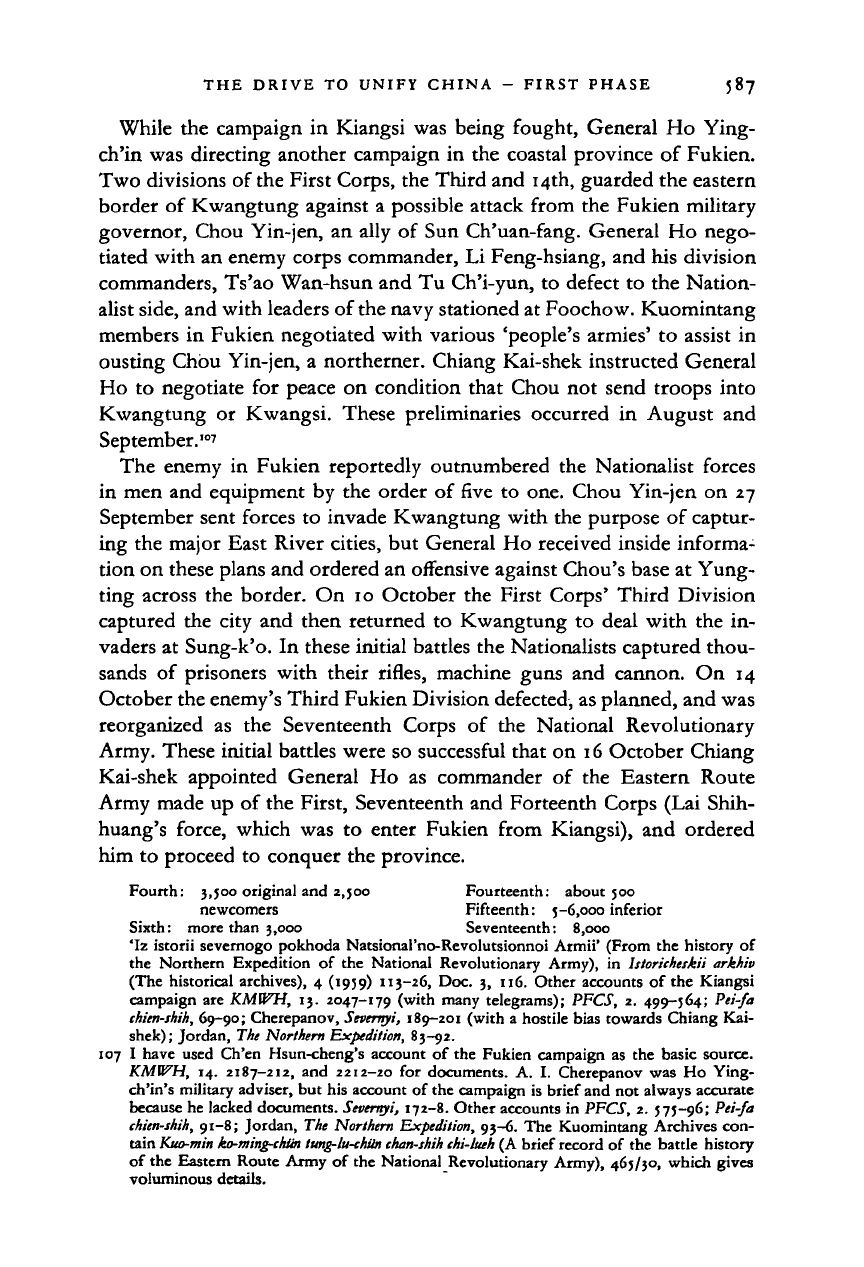
THE DRIVE TO UNIFY CHINA - FIRST PHASE 587
While the campaign in Kiangsi was being fought, General Ho Ying-
ch'in was directing another campaign in the coastal province of Fukien.
Two divisions of the First Corps, the Third and 14th, guarded the eastern
border of Kwangtung against a possible attack from the Fukien military
governor, Chou Yin-jen, an ally of Sun Ch'uan-fang. General Ho nego-
tiated with an enemy corps commander, Li Feng-hsiang, and his division
commanders, Ts'ao Wan-hsun and Tu Ch'i-yun, to defect to the Nation-
alist side, and with leaders of the navy stationed at Foochow. Kuomintang
members in Fukien negotiated with various 'people's armies' to assist in
ousting Chbu Yin-jen, a northerner. Chiang Kai-shek instructed General
Ho to negotiate for peace on condition that Chou not send troops into
Kwangtung or Kwangsi. These preliminaries occurred in August and
September.
107
The enemy in Fukien reportedly outnumbered the Nationalist forces
in men and equipment by the order of five to one. Chou Yin-jen on 27
September sent forces to invade Kwangtung with the purpose of captur-
ing the major East River cities, but General Ho received inside informa-
tion on these plans and ordered an offensive against Chou's base at Yung-
ting across the border. On 10 October the First Corps' Third Division
captured the city and then returned to Kwangtung to deal with the in-
vaders at Sung-k'o. In these initial battles the Nationalists captured thou-
sands of prisoners with their rifles, machine guns and cannon. On 14
October the enemy's Third Fukien Division defected, as planned, and was
reorganized as the Seventeenth Corps of the National Revolutionary
Army. These initial battles were so successful that on 16 October Chiang
Kai-shek appointed General Ho as commander of the Eastern Route
Army made up of the First, Seventeenth and Forteenth Corps (Lai Shih-
huang's force, which was to enter Fukien from Kiangsi), and ordered
him to proceed to conquer the province.
Fourth: 3,500 original and 2,500 Fourteenth: about 500
newcomers Fifteenth: 5-6,000 inferior
Sixth: more than 3,000 Seventeenth: 8,000
'Iz istorii severnogo pokhoda Natsional'no-Revolutsionnoi Armii' (From the history of
the Northern Expedition of the National Revolutionary Army), in Istoricheskii arkhiv
(The historical archives), 4 (1959) 113-26, Doc. 3, 116. Other accounts of the Kiangsi
campaign are
KMU^H,
13. 2047-179 (with many telegrams); PFCS, 2. 499-564; Pei-fa
chien-shih,
69-90; Cherepanov,
Severnyi,
189-201 (with a hostile bias towards Chiang Kai-
shek);
Jordan, The Northern Expedition, 83-92.
107 I have used Ch'en Hsun-cheng's account of the Fukien campaign as the basic source.
KMWH,
14. 2187-212, and 2212-20 for documents. A. I. Cherepanov was Ho Ying-
ch'in's military adviser, but his account of the campaign is brief and not always accurate
because he lacked documents.
Severnyi,
172-8. Other accounts in PFCS, 2. 575-96; Pei-fa
chien-shih,
91-8; Jordan, The Northern Expedition, 93-6. The Kuomintang Archives con-
tain
Kuo-min ko-ming-chiin lung-lu-chiin chan-shih chi-lueh
(A brief record of the battle history
of the Eastern Route Army of the National Revolutionary Army), 465/30, which gives
voluminous details.
Cambridge Histories Online © Cambridge University Press, 2008
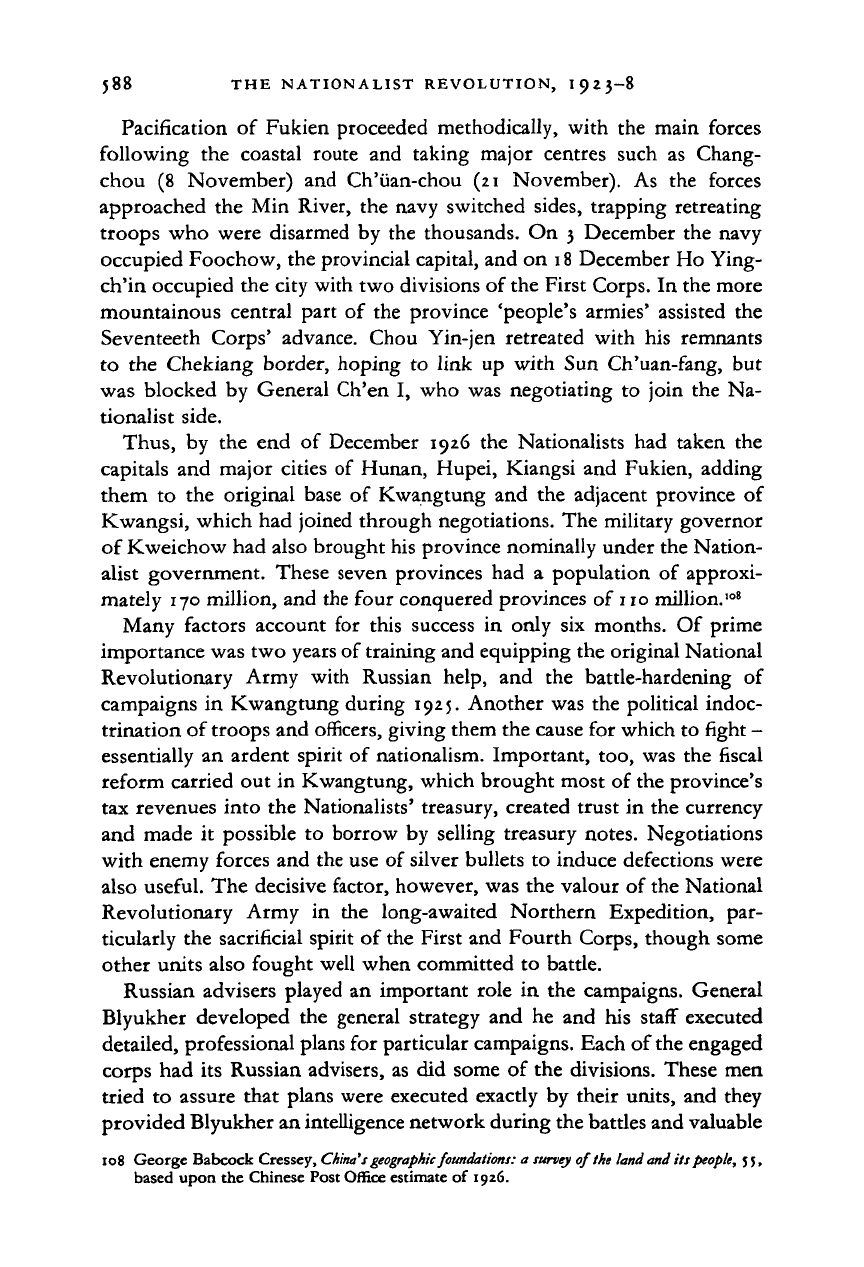
5
88 THE NATIONALIST REVOLUTION, I 9 2 3-8
Pacification
of
Fukien proceeded methodically, with
the
main forces
following
the
coastal route
and
taking major centres such
as
Chang-
chou
(8
November)
and
Ch'iian-chou
(21
November).
As the
forces
approached
the Min
River,
the
navy switched sides, trapping retreating
troops
who
were disarmed
by the
thousands.
On 3
December
the
navy
occupied Foochow, the provincial capital, and
on
18 December
Ho
Ying-
ch'in occupied
the
city with two divisions
of
the First Corps.
In
the more
mountainous central part
of the
province 'people's armies' assisted
the
Seventeeth Corps' advance. Chou Yin-jen retreated with
his
remnants
to
the
Chekiang border, hoping
to
link
up
with
Sun
Ch'uan-fang,
but
was blocked
by
General Ch'en
I, who was
negotiating
to
join
the Na-
tionalist side.
Thus,
by the end of
December
1926 the
Nationalists
had
taken
the
capitals
and
major cities
of
Hunan, Hupei, Kiangsi
and
Fukien, adding
them
to the
original base
of
Kwangtung
and the
adjacent province
of
Kwangsi, which
had
joined through negotiations. The military governor
of Kweichow had also brought his province nominally under the Nation-
alist government. These seven provinces
had a
population
of
approxi-
mately 170 million, and the four conquered provinces
of
110 million.
108
Many factors account
for
this success
in
only
six
months.
Of
prime
importance was two years
of
training and equipping the original National
Revolutionary Army with Russian help,
and the
battle-hardening
of
campaigns
in
Kwangtung during 1925. Another was
the
political indoc-
trination
of
troops and officers, giving them the cause
for
which
to
fight
-
essentially
an
ardent spirit
of
nationalism. Important,
too, was the
fiscal
reform carried
out in
Kwangtung, which brought most
of
the province's
tax revenues into
the
Nationalists' treasury, created trust
in the
currency
and made
it
possible
to
borrow
by
selling treasury notes. Negotiations
with enemy forces
and
the use
of
silver bullets
to
induce defections were
also useful.
The
decisive factor, however, was
the
valour
of
the National
Revolutionary Army
in the
long-awaited Northern Expedition,
par-
ticularly
the
sacrificial spirit
of
the First and Fourth Corps, though some
other units also fought well when committed
to
battle.
Russian advisers played
an
important role
in the
campaigns. General
Blyukher developed
the
general strategy
and he and his
staff executed
detailed, professional plans
for
particular campaigns. Each
of
the engaged
corps
had its
Russian advisers,
as did
some
of
the divisions. These
men
tried
to
assure that plans were executed exactly
by
their units,
and
they
provided Blyukher an intelligence network during the battles and valuable
108 George Babcock Cressey, China's geographic foundations:
a
survey of the land and
its
people, 55,
based upon
the
Chinese Post Office estimate
of
1926.
Cambridge Histories Online © Cambridge University Press, 2008
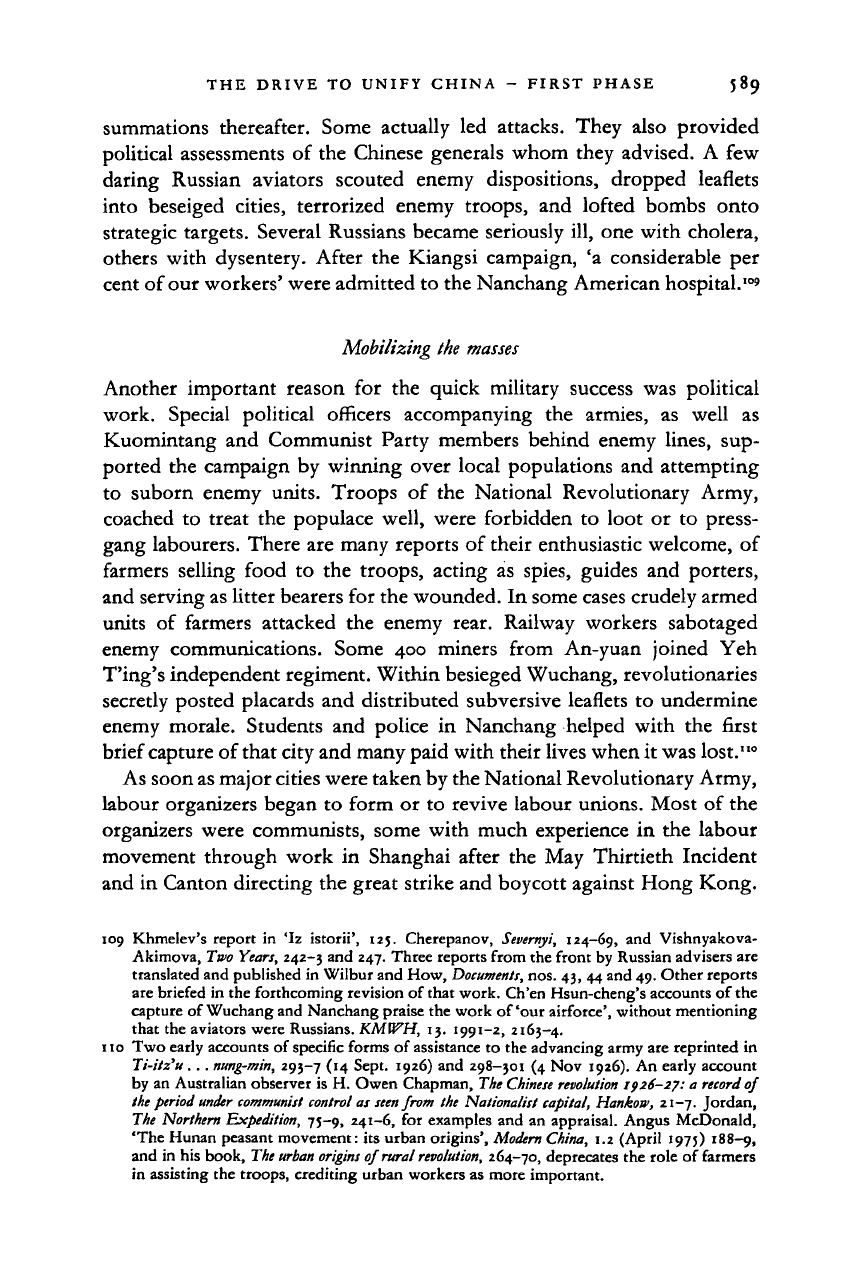
THE DRIVE TO UNIFY CHINA - FIRST PHASE 589
summations thereafter. Some actually led attacks. They also provided
political assessments of the Chinese generals whom they advised. A few
daring Russian aviators scouted enemy dispositions, dropped leaflets
into beseiged cities, terrorized enemy troops, and lofted bombs onto
strategic targets. Several Russians became seriously ill, one with cholera,
others with dysentery. After the Kiangsi campaign, 'a considerable per
cent of our workers' were admitted to the Nanchang American hospital.
10
'
Mobilizing the masses
Another important reason for the quick military success was political
work. Special political officers accompanying the armies, as well as
Kuomintang and Communist Party members behind enemy lines, sup-
ported the campaign by winning over local populations and attempting
to suborn enemy units. Troops of the National Revolutionary Army,
coached to treat the populace well, were forbidden to loot or to press-
gang labourers. There are many reports of their enthusiastic welcome, of
farmers selling food to the troops, acting as spies, guides and porters,
and serving as litter bearers for the wounded. In some cases crudely armed
units of farmers attacked the enemy rear. Railway workers sabotaged
enemy communications. Some 400 miners from An-yuan joined Yeh
T'ing's independent regiment. Within besieged Wuchang, revolutionaries
secretly posted placards and distributed subversive leaflets to undermine
enemy morale. Students and police in Nanchang helped with the first
brief capture of that city and many paid with their lives when it was lost.""
As soon
as
major cities were taken by the National Revolutionary Army,
labour organizers began to form or to revive labour unions. Most of the
organizers were communists, some with much experience in the labour
movement through work in Shanghai after the May Thirtieth Incident
and in Canton directing the great strike and boycott against Hong Kong.
109 Khmelev's report in 'Iz istorii', 125. Cherepanov, Severnyi, 124-69, and Vishnyakova-
Akimova, Two Years, 242-3 and 247. Three reports from the front by Russian advisers are
translated and published in Wilbur and How,
Documents,
nos. 43, 44 and 49. Other reports
are briefed in the forthcoming revision of that work. Ch'en Hsun-cheng's accounts of the
capture of Wuchang and Nanchang praise the work of 'our airforce', without mentioning
that the aviators were Russians.
KMWH,
13. 1991-2, 2:63-4.
110 Two early accounts of specific forms of assistance to the advancing army are reprinted in
Ti-ilz'u .. . nmg-min, 293-7 (14 Sept. 1926) and 298-301 (4 Nov 1926). An early account
by an Australian observer is H. Owen Chapman,
The Chinese revolution
1926-27: a
record of
the
period
under communist control
as
seen
from the Nationalist capital, Hankow, 21-7. Jordan,
The Northern Expedition, 75-9, 241-6, for examples and an appraisal. Angus McDonald,
'The Hunan peasant movement: its urban origins',
Modern
China,
1.2 (April 1975) 188-9,
and in his book,
The urban origins
of rural
revolution,
264-70, deprecates the role of farmers
in assisting the troops, crediting urban workers as more important.
Cambridge Histories Online © Cambridge University Press, 2008
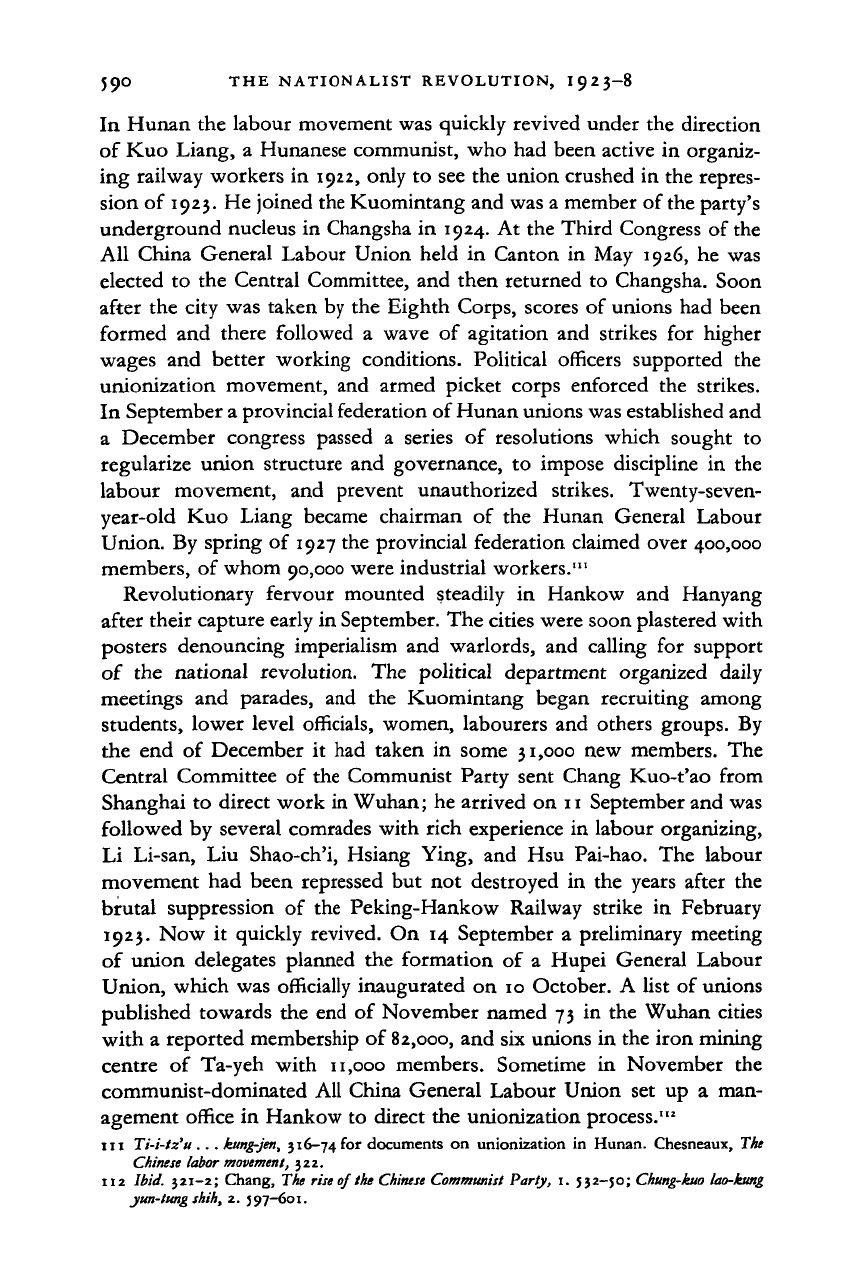
590 THE NATIONALIST REVOLUTION, I923-8
In Hunan the labour movement was quickly revived under the direction
of Kuo Liang,
a
Hunanese communist, who had been active
in
organiz-
ing railway workers
in
1922, only
to
see the union crushed in the repres-
sion
of
1923. He joined the Kuomintang and was a member of the party's
underground nucleus in Changsha in 1924. At the Third Congress of the
All China General Labour Union held
in
Canton
in
May 1926,
he
was
elected
to
the Central Committee, and then returned
to
Changsha. Soon
after the city was taken by the Eighth Corps, scores
of
unions had been
formed
and
there followed
a
wave
of
agitation and strikes
for
higher
wages
and
better working conditions. Political officers supported
the
unionization movement,
and
armed picket corps enforced
the
strikes.
In September a provincial federation of Hunan unions was established and
a December congress passed
a
series
of
resolutions which sought
to
regularize union structure and governance,
to
impose discipline
in the
labour movement,
and
prevent unauthorized strikes. Twenty-seven-
year-old
Kuo
Liang became chairman
of the
Hunan General Labour
Union. By spring
of
1927 the provincial federation claimed over 400,000
members,
of
whom 90,000 were industrial workers."
1
Revolutionary fervour mounted steadily
in
Hankow
and
Hanyang
after their capture early in September. The cities were soon plastered with
posters denouncing imperialism and warlords,
and
calling
for
support
of
the
national revolution.
The
political department organized daily
meetings
and
parades,
and the
Kuomintang began recruiting among
students, lower level officials, women, labourers and others groups.
By
the end
of
December
it
had taken
in
some 31,000 new members.
The
Central Committee
of
the Communist Party sent Chang Kuo-t'ao from
Shanghai
to
direct work in Wuhan; he arrived on 11 September and was
followed by several comrades with rich experience in labour organizing,
Li Li-san,
Liu
Shao-ch'i, Hsiang Ying,
and
Hsu Pai-hao.
The
labour
movement had been repressed but
not
destroyed
in
the years after
the
brutal suppression
of
the Peking-Hankow Railway strike
in
February
1923.
Now
it
quickly revived.
On
14 September
a
preliminary meeting
of union delegates planned the formation
of a
Hupei General Labour
Union, which was officially inaugurated
on
10 October.
A
list of unions
published towards the end
of
November named 73
in
the Wuhan cities
with
a
reported membership
of
82,000, and six unions in the iron mining
centre
of
Ta-yeh with 11,000 members. Sometime
in
November
the
communist-dominated All China General Labour Union
set up a
man-
agement office in Hankow to direct the unionization process.
112
in Ti-i-tz'u
. . .
Jkung-jen,
316-74
for
documents
on
unionization
in
Hunan. Chesneaux, The
Chinese
labor
movement,
322.
112
Ibid.
321-2; Chang, The rise of
the Chinese
Communist Party,
1.
532-50;
Chung-kuo lao-kung
yun-tung
shih,
2.
597-601.
Cambridge Histories Online © Cambridge University Press, 2008
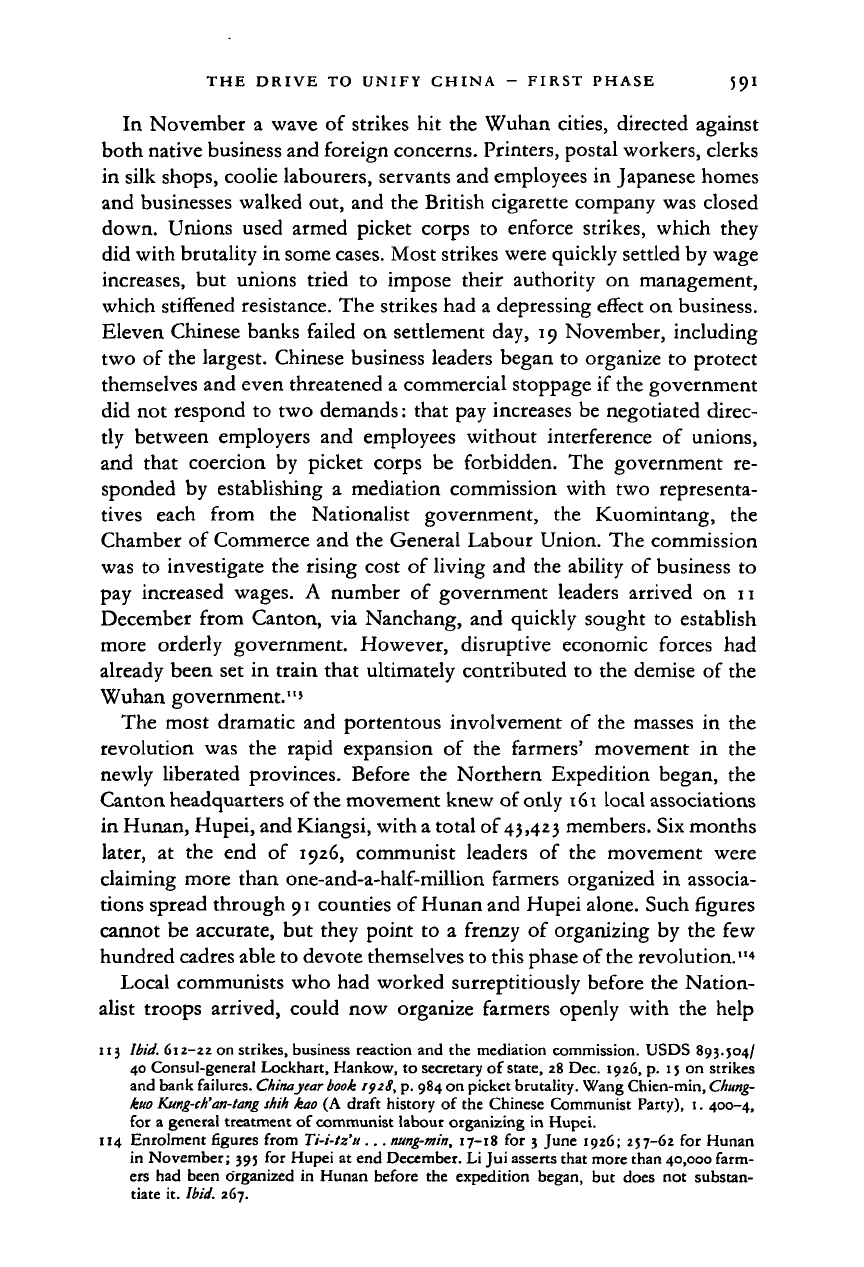
THE DRIVE TO UNIFY CHINA - FIRST PHASE 591
In November a wave of strikes hit the Wuhan cities, directed against
both native business and foreign concerns. Printers, postal workers, clerks
in silk shops, coolie labourers, servants and employees in Japanese homes
and businesses walked out, and the British cigarette company was closed
down. Unions used armed picket corps to enforce strikes, which they
did with brutality in some cases. Most strikes were quickly settled by wage
increases, but unions tried to impose their authority on management,
which stiffened resistance. The strikes had a depressing effect on business.
Eleven Chinese banks failed on settlement day, 19 November, including
two of the largest. Chinese business leaders began to organize to protect
themselves and even threatened a commercial stoppage if the government
did not respond to two demands: that pay increases be negotiated direc-
tly between employers and employees without interference of unions,
and that coercion by picket corps be forbidden. The government re-
sponded by establishing a mediation commission with two representa-
tives each from the Nationalist government, the Kuomintang, the
Chamber of Commerce and the General Labour Union. The commission
was to investigate the rising cost of living and the ability of business to
pay increased wages. A number of government leaders arrived on 11
December from Canton, via Nanchang, and quickly sought to establish
more orderly government. However, disruptive economic forces had
already been set in train that ultimately contributed to the demise of the
Wuhan government."'
The most dramatic and portentous involvement of the masses in the
revolution was the rapid expansion of the farmers' movement in the
newly liberated provinces. Before the Northern Expedition began, the
Canton headquarters of the movement knew of only 161 local associations
in Hunan, Hupei, and Kiangsi, with a total of 43,423 members. Six months
later, at the end of 1926, communist leaders of the movement were
claiming more than one-and-a-half-million farmers organized in associa-
tions spread through
91
counties of Hunan and Hupei alone. Such figures
cannot be accurate, but they point to a frenzy of organizing by the few
hundred cadres able to devote themselves to this phase of
the
revolution."
4
Local communists who had worked surreptitiously before the Nation-
alist troops arrived, could now organize farmers openly with the help
113
Ibid.
612-22 on strikes, business reaction and the mediation commission. USDS 893.504/
40 Consul-general Lockhart, Hankow, to secretary of
state,
28 Dec. 1926, p. 15 on strikes
and bank failures. China
year book
192S,
p. 984 on picket brutality. Wang Chien-min,
Chung-
kuo Kung-ch'an-tang shih kao
(A draft history of the Chinese Communist Party), 1. 400-4,
for a general treatment of communist labour organizing in Hupei.
114 Enrolment figures from Ti-i-tz'a . . .
nung-min,
17-18 for 3 June 1926; 257-62 for Hunan
in November; 395 for Hupei at end December. Li Jui asserts that more than 40,000 farm-
ers had been organized in Hunan before the expedition began, but does not substan-
tiate it.
Ibid.
267.
Cambridge Histories Online © Cambridge University Press, 2008
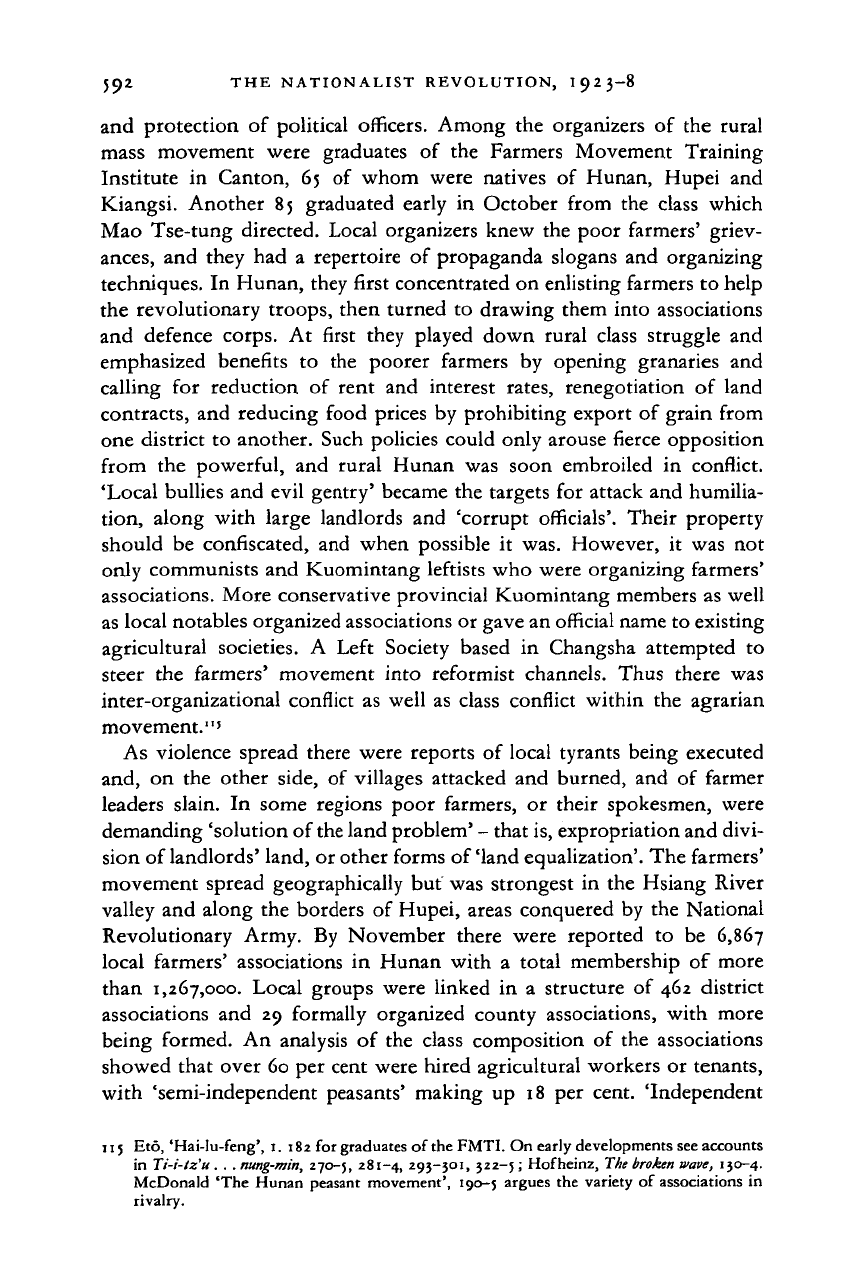
592 THE NATIONALIST REVOLUTION, I923-8
and protection
of
political officers. Among
the
organizers
of the
rural
mass movement were graduates
of the
Farmers Movement Training
Institute
in
Canton,
65 of
whom were natives
of
Hunan, Hupei
and
Kiangsi. Another
85
graduated early
in
October from
the
class which
Mao Tse-tung directed. Local organizers knew
the
poor farmers' griev-
ances,
and
they
had a
repertoire
of
propaganda slogans
and
organizing
techniques.
In
Hunan, they first concentrated
on
enlisting farmers
to
help
the revolutionary troops, then turned
to
drawing them into associations
and defence corps.
At
first they played down rural class struggle
and
emphasized benefits
to the
poorer farmers
by
opening granaries
and
calling
for
reduction
of
rent
and
interest rates, renegotiation
of
land
contracts,
and
reducing food prices
by
prohibiting export
of
grain from
one district
to
another. Such policies could only arouse fierce opposition
from
the
powerful,
and
rural Hunan
was
soon embroiled
in
conflict.
'Local bullies
and
evil gentry' became
the
targets
for
attack
and
humilia-
tion, along with large landlords
and
'corrupt officials'. Their property
should
be
confiscated,
and
when possible
it
was. However,
it was not
only communists
and
Kuomintang leftists who were organizing farmers'
associations. More conservative provincial Kuomintang members
as
well
as local notables organized associations
or
gave an official name to existing
agricultural societies.
A
Left Society based
in
Changsha attempted
to
steer
the
farmers' movement into reformist channels. Thus there
was
inter-organizational conflict
as
well
as
class conflict within
the
agrarian
movement."'
As violence spread there were reports
of
local tyrants being executed
and,
on the
other side,
of
villages attacked
and
burned,
and of
farmer
leaders slain.
In
some regions poor farmers,
or
their spokesmen, were
demanding 'solution of
the
land problem'
-
that is, expropriation and divi-
sion
of
landlords' land,
or
other forms of'land equalization'. The farmers'
movement spread geographically
but
was strongest
in the
Hsiang River
valley
and
along
the
borders
of
Hupei, areas conquered
by the
National
Revolutionary Army.
By
November there were reported
to be
6,867
local farmers' associations
in
Hunan with
a
total membership
of
more
than 1,267,000. Local groups were linked
in a
structure
of
462 district
associations
and 29
formally organized county associations, with more
being formed.
An
analysis
of the
class composition
of the
associations
showed that over 60
per
cent were hired agricultural workers
or
tenants,
with 'semi-independent peasants' making
up 18 per
cent. 'Independent
115 Eto, 'Hai-Iu-feng', 1. 182 for graduates
of
the FMTI. On early developments see accounts
in Ti-i-tz'u .
.
.
nung-min,
270-5, 281-4,
295—301,
522-5; Hofheinz,
The broken
wave,
130-4.
McDonald 'The Hunan peasant movement', 190-5 argues
the
variety
of
associations
in
rivalry-
Cambridge Histories Online © Cambridge University Press, 2008
